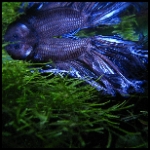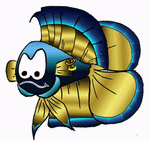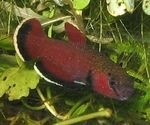Pol
Halfmoon Marbré Rouge


Date d'inscription : 29/03/2011
 |  Sujet: Re: La vue Sujet: Re: La vue  Sam 13 Aoû 2011, 15:53 Sam 13 Aoû 2011, 15:53 | |
| Escusez-moi tous, je pense qu'au final je m'exprime très mal...! Je suis tout à fait d'accord avec vous et je ne voulais pas parler de lucidité dans le sens intelligence et capacité à interpréter des choses ou y réfléchir dessus mais plutôt dans l'idée qu'il y a quelque chose d'étonnant dans ce poisson. Je dis ça mais je n'ai eu qu'un combattant...! Encoré désolé pour les HS ou multiples erreurs de ma part!  |
|
brunoorleans
Super Splendens


Date d'inscription : 11/06/2010
 |  Sujet: Re: La vue Sujet: Re: La vue  Mar 16 Aoû 2011, 00:09 Mar 16 Aoû 2011, 00:09 | |
| Perso j'ai remarqué qu'ils connaissent bien les couleurs et qu'ils sont pas si bête, en tout cas ils ont bien une mémoire liée je pense aux couleurs...
Quand je les nourris aux artémias je les mets avec une baguette chinoise rouge. J'ai même pas le temps de tremper le bout dans l'eau que c'est la panique.
Mon mâle saute direct au bout de la baguette même pas encore dans l'eau.
Par contre j'ai une baguette en bois beige de barbe à papa qui me sert à d'autres trucs, et là aucun poisson ne réagit.
Dans mon bac d'ensemble des fois je m'amuse à passer la baguette rouge devant la vitre et là tous les tétras sont fous, ils se rassemblent tous au milieu pour attendre que les artémias tombent. |
|
bettabondieu
Eleveur/éleveuse

Date d'inscription : 22/06/2010
 |  Sujet: Re: La vue Sujet: Re: La vue  Mar 16 Aoû 2011, 08:36 Mar 16 Aoû 2011, 08:36 | |
| Expérience intéressante  mais cela ne démontre pas qu'ils voient en couleur mais peut-être en noir et blanc : la baguette rouge pouvant être perçue plus foncée (gris foncée) que la baguette beige (gris clair ou blanc) Il faudrait faire cette expérience avec des baguettes ayant le même ton de couleur (et même forme bien-sûr !) par exemple rouge, et son équivalent gris (un peu comme si tu avais pris cette baguette sur une photo noir et blanc) ou des couleurs diverses, mais présentant le même ton de gris. Et même dans ce cas... il faudrait voir s'il ne sont pas sensibles qu'à certaines couleurs (genre le rouge, et le reste en noir et blanc) Donc : de quelle manière les différences entre les couleurs sont-elles perçues ?  |
|
claire
DT Gold Administrateur


Date d'inscription : 01/07/2005
 |  Sujet: Re: La vue Sujet: Re: La vue  Mar 16 Aoû 2011, 11:33 Mar 16 Aoû 2011, 11:33 | |
| - Citation :
- cela ne démontre pas qu'ils voient en couleur
La rétine des Bettas contient des cônes et des bâtonnets, les cônes sont les photorécepteurs pour les couleurs. Il y a eu diverses expériences concernant la vision des couleurs chez les Bettas, mais je n'ai pas les références, et pas le temps de les chercher. Victoria Parnell Starck a écrit ce petit texte sur "l'intelligence" des Bettas... - Citation :
- Are Bettas Intelligent?
By:
Submitted: 9/22/2004
Click for Larger Image
Physical Problem Solving
Bettas don't engage in 'deductive or thinking action' but rely instead on instinct. There is anatomical evidence of this in that the optic lobe and cerebellum are about equal in size and farther back, and the olfactory bulbs are more towards the front and larger. From this scientists have learned that the senses of sight and smell are of great importance to the betta. The keen eyes of the betta can see color and are situated on their axis so that they can rotate outwards and provide excellent peripheral vision to the betta. The ability to see color and the ability to see peripherally gives the betta a considerable advantage over other fish of relatively the same size in that they can avoid predation better. Of the senses, eyesight has been studied the most extensively. With regards to smell, pheromonal control over social behavior is known to occur but isn't well understood, so our focus will be on eyesight.
Ability to see color affects the Betta's habitat selection process. It seems that nest site selection is just as intricate a process as the construction of the nest itself. Gude's studies in lab aquaria in 1965 showed that Bettas preferred yellow colors of vegetation and light over green, red and blue. Bettas usually showed a preference for lower intensity color, but intensity wasn't as determining a factor as location on the color spectrum. At all costs, colors were preferred over gray, black, and white. The order of preference was 'yellow, green, red, light gray or dark gray, white, blue and black'(Gude 1965,45). Blue and black were least preferred because they transmitted the least light, and some light is required, although bettas don't prefer that much light, so white was third to last. As a result of his studies, Gude came up with 2 hypothesis to explain this color preference. One is the 'Natural Preference Hypothesis' which states that 'fish show distinct preferences for the same colors transmitted by leaves under which they build their nests in nature' (Gude 1965,37). The other is the 'Negative Preference Hypothesis' which takes into account the Betta's tendency for aggression and notes that 'the aggressive coloration of the fish is predominantly in the blue range with some red and a slight amount of green' (Gude 1965,37). However, the sky is also blue, and Gude stated that this might be a reason for the avoidance of it as well, because in the wild it would mean improper vegetal coverage. Gude also recognized that 'factors unknown' may be involved as well. It should be noted that Gude's method of research seems to be rather questionable. He tested Bettas' color preferences by placing colored disks in the water that were calibrated to transmit the same wavelength of light (or very close to it) as natural light and colors. The fish were then scored on the percentage of times a territory was established under a specific disk. This approximation of light seems to indicate a certain looseness in Gude's studies. It's possible that the betta is so in tuned to colors and intensities in nature that even slightly varying degrees of them cause a change in it's behavior. It is also possible that the aggression that Gude thinks is related to color may also be linked to phemorones, but Gude didn't test that. This may be the reason for his disclaimer of unknown factors. Perhaps this fascinating research was left out of Drickamer, Vessey and Meickel's text and other studies on animal behavior for the reason that Gude didn't pursue all possible facets of this study. However, his study does add more credence to previous findings that Bettas can't survive in very low light for long and as such become quiet and move little at night. Gude's findings also support earlier indications that the Betta needs a reasonable amount of light to spawn, thereby indicating that color signals are important to its behavior. As important to the Betta as color vision is, it seems that oxygen is not. Bettas can survive long periods in overcrowded and fouled water. This is due to their accessory breathing organ which allows them to use atmospheric air. With this breathing system they are well equipped to live in shallow water with little oxygen. Their slow movements and strong pectoral fins are indicative of life in a slow moving or still water environment, and indeed in the wild they inhabit rice paddies and weed choked ditches.
Social Problem Solving
Territoriality and nest building is usually found in fishes that live in a limited environment like a rice paddy. This has been well studied in labs in an effort to learn more about the elaborate mechanisms associated with the display behavior between male conspecifics. Display between male bettas indicates aggressive motivation. The encounter begins when a male sights a male nonspecific and turns towards it. In the process it's color deepens, gill cover extends, and fins spread. The fish orient in a 90 degree angle to each other such that one faces the conspecific's side. When broadside the betta doesn't extend it's fins and gill covers but 'will flash and beat it's tail'. The beating and tail flashing makes the facing fish turn broadside. The broadside fish now turns and exhibits the behavior of a facing fish. The two fish alternate between these positions for quite some time. If tailbeating hasn't resulted in submission by either of the two fish, 'carouselling' can occur. Carouselling is when the fish are broadside to each other but their heads and tails are in opposite directions. They maintain this position while using their pectoral fins to rotate. Carouselling is followed by air gulping which mimics the behavior of nest building and also gives the fish the air they need to survive. Carouselling and air gulping indicate that physical contact is imminent. The fight sequence begins when one fish noses the other. If biting of the fins and chasing occur the fight may end as soon as it starts but can progress further and become more deadly. Biting and chasing continues with brief breaks to get air. The fish both swim to the surface at the same time to gulp air and then return to the fight. Rarely the fish will engage in 'mouth locking' which is where one fish takes hold of the other's mouth with its own mouth. Both of them lie perpendicular to the bottom of the tank locked in this deadly grip. They remain relatively motionless until one of them moves to break it off in an effort to surface for air. Usually the fight doesn't go this far, and one fish will subordinate itself earlier in the sequence and end the fight. The dominant/subordinate relationship that is established after a fight prevents further fighting among the two. This agonistic behavior has been measured in the lab using MIS. MIS stands for Mirror Image Stimulation and has long been considered a measure of agonistic motivation in male bettas. MIS is simple to set up and test as it is just a mirror placed in the tank of the betta. The betta thinks it is another male and will show the display behavior of spreading fins and gill cover extension. The scientists record duration and frequency of display to MIS in an effort to understand the mechanisms of the betta's supreme agonotism. It has been found that there is a direct correlation between display behavior to MIS and propensity to display to male conspecific (MacIntosh 1991). Using this, scientists have come to a fuller understanding of the need for display. Display has the potential to establish rank order on its own without resulting in a fight. Display behavior is so hardwired that MIS has also found that, while subordinate fish will stop fighting dominant fish, they will continue to display to other fish. The key difference between a dominant and subordinate fish is that dominant fish display for shorter duration but more frequently than subordinate fish. Fighting is greatly affected by social experience and learning but the correlation between actual fighting and display to MIS are unclear. One reason for this is that display behavior can be replaced by a number of behaviors more appropriate to the situation, such as nosing, biting or fleeing. Another reason is that bettas will try to match the intensity of their opponents in an actual fight. Although display is hardwired, fighting is subject to learning, and social experience can effect this aggressive motivation also. Winning is continual reinforcement and increases success such that winners will become more highly motivated to fight rather than just display. Social experience effects in MacIntosh's own studies found that fish that experience winning display to MIS more frequently than subordinate fish or fish without social experience. Fish that have become subordinated don't differ significantly from fish without social experience, but once these subordinated fish have more social experience they will increase their frequency of display to MIS.
Works Cited
Ritter, R. 'Behavior of the Beautiful Betta Splendens'.
Bronstein, Paul M. 'Breeding, Paternal Behavior and Their Interruption in Betta Splendens'. Journal of the Psychonomic Society,Inc., 10.2 (1982): 145-151.
Drickamer, Vessey and Meikle. Animal Behavior. 4th edition. Boston:Wm. C. Brown Publishers, 1996
Gude, Richard. Relationship Between Color Preferences and Nest Site Selection in the Siamese Fighting Fish, Betta Splendens(Regan). Thesis. Michigan State University, 1965. Ann Arbor:UMI, 1965. 1422665.
MacIntosh, Thomas D. 'Social Experience an Mirror Image Stimulation in Male Betta Splendens'. Thesis. Villanova University, 1991.
White, William Jr. The Siamese Fighting Fish: It's Life Cycle. Colorful Nature Ser. 3. New York: Sterling Publishing, Co. Inc.,1975. _________________  N'oubliez pas d'utiliser la  sur le forum.  |
|
Pacu
Plakat Dragon


Date d'inscription : 04/07/2005
 |  Sujet: Re: La vue Sujet: Re: La vue  Mar 16 Aoû 2011, 19:46 Mar 16 Aoû 2011, 19:46 | |
| A propos de la vision en couleur:
Les poissons en général voient mieux les couleurs que nous. (Je n'ai pas d'infos plus précises en ce qui concerne le Betta en particulier.)
Nous voyons 3 couleurs de base, les poissons 4 (vision en tetrachromie) et le chien voit en bichromie.
|
|




